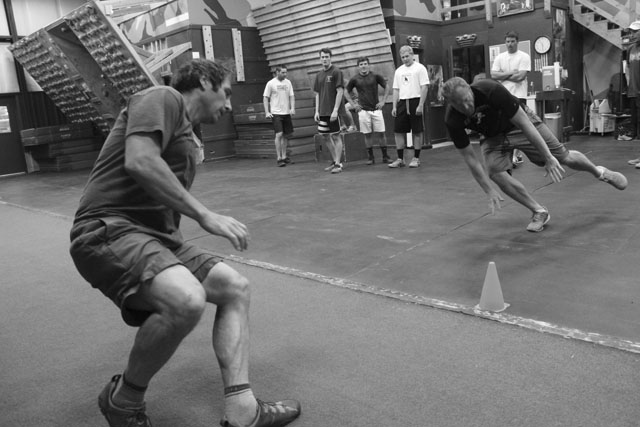The Tactical Agility Program has undergone various changes from its initial version (V1.0) to the latest guidelines outlined in version 3 (V3.0). These updates reflect an evolving understanding of tactical agility needs and the incorporation of new training methodologies. Below is a comparison of the main differences and how our programming guidelines have changed.
Purpose of Tactical Agility
The primary purpose of the Tactical Agility Program is to familiarize the tactical athlete with common movement patterns they will need to deploy under fire and in varying tactical situations. This fundamental goal remains consistent across both versions, ensuring the training is practical and applicable to real-world scenarios.
Differences Between Sport Agility Training and Tactical Agility Training
Sports agility training focuses on enhancing performance in controlled environments, typically involving rapid changes in direction, speed, and coordination specific to a particular sport. Tactical agility training prepares athletes for unpredictable and high-stress situations encountered in military, law enforcement, and firefighting operations. It includes not only speed and directional changes but also movement patterns such as crawling, dragging, and navigating obstacles under load, often simulating real-world scenarios where familiarization with these movements is necessary.
V1.0 Overview
The original approach to tactical agility emphasized foundational movement patterns and drills designed to enhance basic agility. The core elements included:
Basic Drill Selection:
- Focused on core movements such as sprinting, level changes, and obstacle navigation to build foundational agility.
- Drills were designed to be straightforward, ensuring athletes could easily understand and execute them.
Frequency and Volume:
- Recommended 1-2 sessions per week to build familiarity and avoid overtraining.
- Sessions were structured to gradually introduce the athlete to tactical agility, focusing on consistent, moderate-intensity training.
Warm-Up and Training Integration:
- Warm-ups included basic mobility exercises and light drills to prepare the body for more intense activities.
- Training sessions incorporated these drills progressively, starting with lower intensity and gradually increasing as the athlete adapted.
Movement Patterns:
- Sprint: Basic sprinting drills to enhance speed and acceleration.
- Level Change: Simple movements like standing to prone or vice versa to improve balance and coordination.
- Navigate Obstacles: Basic obstacle navigation, such as stepping over or around objects, focuses on agility and spatial awareness.
V3.0 Enhancements
The new guidelines in V3.0 provide a more comprehensive integration of tactical scenarios and the specific physical demands for each occupation. These guidelines are informed by a survey of 266 responses, which identified the most common movement patterns required in high-risk scenarios.
Expanded Movement Patterns:
Sprint:
- From Patrol: Sprinting from a walking or jogging pace, simulating the need to quickly accelerate into a full sprint.
- Examples: Sprinting from a standard foot patrol across a dangerous area.
Level Change:
- Elevation Changes: Movements that involve changing elevations, such as dropping from a height or jumping up.
- Example: Unknown drops in a smoke-filled room, jumping over obstacle to take cover.
- Position Transitions: Moving from prone to standing, kneeling to standing positions, emphasizing quick, fluid transitions.
Navigate Obstacles:
- Circumventing: Moving around obstacles efficiently to maintain momentum and speed.
- Example: In foot pursuit and required to go around obstacles while chasing a criminal.
- Sprinting to Stop: Rapid acceleration followed by an abrupt stop to avoid an obstacle or threat, training the ability to quickly decelerate and maintain control.
Crawl:
- Crawling varying style: This includes various crawling techniques, such as high and low crawling.
- Example: Movement through a smoke-filled space. Staying low to maintain visibility and avoid heat
Drag:
- Crawling Drags: Dragging while crawling to maintain a low profile, simulating situations where staying low is crucial for safety.
- Example: Movement through a smoked-filled space while pulling a hose.
Development of four new drills that accomplish 75-100% of prescribed movement pattern in one drill:
- Tactical Agility Sandbag Crawl: Combines level changes, obstacle navigation, crawling, and dragging. This targets Fire/Rescue professionals who need to move hoses and hand tools while maintaining a low profile in a smoky environment.
- Tactical Agility 75m Shuttle with Burpee Box Jump: This exercise incorporates sprints, level changes through jumps and drops, and obstacle navigation. It can also serve as a work capacity exercise.
- Tactical Agility 10/20/10 (starting from prone, back, or kneeling): Adjustable to start from a back or kneeling position or perform a technical standup. Transitions to a sprint, followed by obstacle navigation, another sprint, and a hard cut to the finish.
- Tactical Agility Sandbag Serpentine: It can be adjusted to start from a back or kneeling position or perform a technical standup (level change). It includes sprints and obstacle avoidance and can serve as a work capacity exercise.
Training Intensity:
- Load and Progression: Introduces weighted vests and specific equipment like 25# ruck to better simulate field conditions for Fire/Rescue. These drills require deliberate action (slowing down if needed) to perform safe and correct movements.
Warm-Up and Fatigue State Drills:
- Warm-Up: Incorporates unweighted tactical agility drills at an easy pace to familiarize movement patterns.
- Fatigue State Drills: Utilize specific Tactical Agility drills within mini-events to sensitize the athletes to these movements while tired.
-
- Tactical Agility sandbag serpentine
- Tactical Agility 75m shuttle with burpee box jump on each end
- Tactical Agility burpee box drill
-
Work Capacity Integration:
- Work Capacity Drills: Incorporate appropriate Tactical Agility drills into work capacity events.
Our Ongoing Evolution
We understand that without specific training sessions, few athletes would naturally incorporate these movements into their routines. Our primary goal is to enhance mission-direct performance, ensuring that the first time our athletes must move from prone to a sprint, navigate an obstacle, and return to prone while in full gear isn’t in a real-life scenario.
We want our athletes to be familiar with and experienced in these movements as part of their daily training. Your input is invaluable as we continue to evolve and improve our program. Please share your feedback to help us make our tactical agility training even better.


